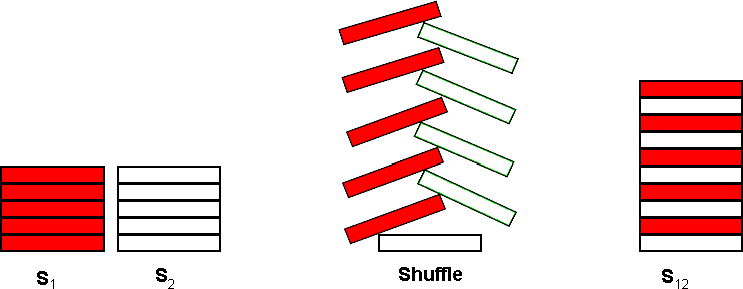[模拟]POJ 3087 Shuffle'm up
来源:互联网 发布:mac keeper 破解版 编辑:程序博客网 时间:2024/05/16 15:17
Description
A common pastime for poker players at a poker table is to shuffle stacks of chips. Shuffling chips is performed by starting with two stacks of poker chips, S1 and S2, each stack containing C chips. Each stack may contain chips of several different colors.
The actual shuffle operation is performed by interleaving a chip from S1 with a chip from S2 as shown below for C = 5:

The single resultant stack, S12, contains 2 * C chips. The bottommost chip of S12 is the bottommost chip from S2. On top of that chip, is the bottommost chip from S1. The interleaving process continues taking the 2nd chip from the bottom of S2 and placing that on S12, followed by the 2nd chip from the bottom of S1 and so on until the topmost chip from S1 is placed on top of S12.
After the shuffle operation, S12 is split into 2 new stacks by taking the bottommost C chips from S12 to form a new S1 and the topmost C chips from S12 to form a new S2. The shuffle operation may then be repeated to form a new S12.
For this problem, you will write a program to determine if a particular resultant stack S12 can be formed by shuffling two stacks some number of times.
Input
The first line of input contains a single integer N, (1 ≤ N ≤ 1000) which is the number of datasets that follow.
Each dataset consists of four lines of input. The first line of a dataset specifies an integer C, (1 ≤ C ≤ 100) which is the number of chips in each initial stack (S1 and S2). The second line of each dataset specifies the colors of each of the C chips in stack S1, starting with the bottommost chip. The third line of each dataset specifies the colors of each of the C chips in stack S2 starting with the bottommost chip. Colors are expressed as a single uppercase letter (A through H). There are no blanks or separators between the chip colors. The fourth line of each dataset contains 2 * C uppercase letters (A through H), representing the colors of the desired result of the shuffling of S1and S2 zero or more times. The bottommost chip’s color is specified first.
Output
Output for each dataset consists of a single line that displays the dataset number (1 though N), a space, and an integer value which is the minimum number of shuffle operations required to get the desired resultant stack. If the desired result can not be reached using the input for the dataset, display the value negative 1 (−1) for the number of shuffle operations.
Sample Input
24AHAHHAHAHHAAAAHH3CDECDEEEDDCC
Sample Output
1 22 -1
一道奇怪的模拟题,或者说是一个退化的BFSh或DFS吧,说它退化是因为他搜索的方向只有一种情况。。
模拟的时候注意题目所给的条件就行了。注意关键的判断条件:什么时候输出不可能的情况?当S1和S2又回到初始状态时就可以决定跳出了。因为经过一整个字符串的循环变化以后,直到回到初始状态,无限循环下去。
#include<iostream>#include<cstring>using namespace std;int main(){ int n, c; char s1[105], s2[105], s12[210], des[210]; cin >> n; for(int t = 1; t <= n; t ++){ cin >> c >> s1 >> s2 >> des; int ans = 0; bool flag = false; char str1[105]; strcpy(str1, s1); // str1保存原始状态的s1。 while(!flag){ int i, k = 0; for(i = 0; i < c; i ++){ // s1和s2按规则合成s12。 s12[k ++] = s2[i]; s12[k ++] = s1[i]; } s12[k] = 0; ans ++; if(!strcmp(s12, des)){ // 若s12与目标相同。 flag = true; break; } for(i = 0, k = 0; k < c; k ++) // 新的s1。 s1[i ++] = s12[k]; s1[i] = 0; for(i = 0, k = c; k < 2 * c; k ++) // 新的s2。 s2[i ++] = s12[k]; s2[i] = 0; if(!strcmp(s1, str1)) // 等到s1经过x次变换后回到str1,则说明不可能到达目标情况了。 break; } if(flag) cout << t << ' ' << ans << endl; else cout << t << " -1" << endl; } return 0;}- POJ 3087 Shuffle'm Up 模拟
- poj-3087-Shuffle'm Up-模拟
- POJ 3087 Shuffle'm Up(模拟题)
- POJ 3087 Shuffle'm Up (模拟)
- poj 3087 Shuffle'm Up (模拟)
- POJ 3087 Shuffle'm Up(模拟)
- POJ 3087 Shuffle'm Up(模拟)
- POJ 3087 Shuffle'm Up (模拟)
- POJ 3087 Shuffle'm Up(模拟)
- Shuffle'm Up (poj 3087 模拟)
- poj 3087 Shuffle'm Up(模拟题)
- [模拟]POJ 3087 Shuffle'm up
- poj 3087 Shuffle'm Up 模拟
- POJ 3087 Shuffle'm Up - 模拟
- POJ 3087 Shuffle'm Up(模拟)
- 模拟-POJ-3087-Shuffle'm up
- POJ 3087-Shuffle'm Up(map+模拟)
- poj-3087-Shuffle'm Up-模拟
- 手把手教你使用git
- 何谓真正的朋友
- 基于深度神经网络的视频监控系统的车辆识别构思
- 数据结构 - 串的性质和基本操作(二)
- AfxGetApp()->GetMainWnd()和AfxGetMainWnd()的区别
- [模拟]POJ 3087 Shuffle'm up
- iOS开发中如何高效使用MVC设计模式
- 昆明什么地方可以有偿捐献肾
- 图床:使用新浪微博相册
- CentOS7 安装wget
- iOS 7、iOS 8屏幕适配
- Nodejs学习路线图
- WebSphere Message Broker 介绍
- ThreadPoolExecutor 线程池 介绍


